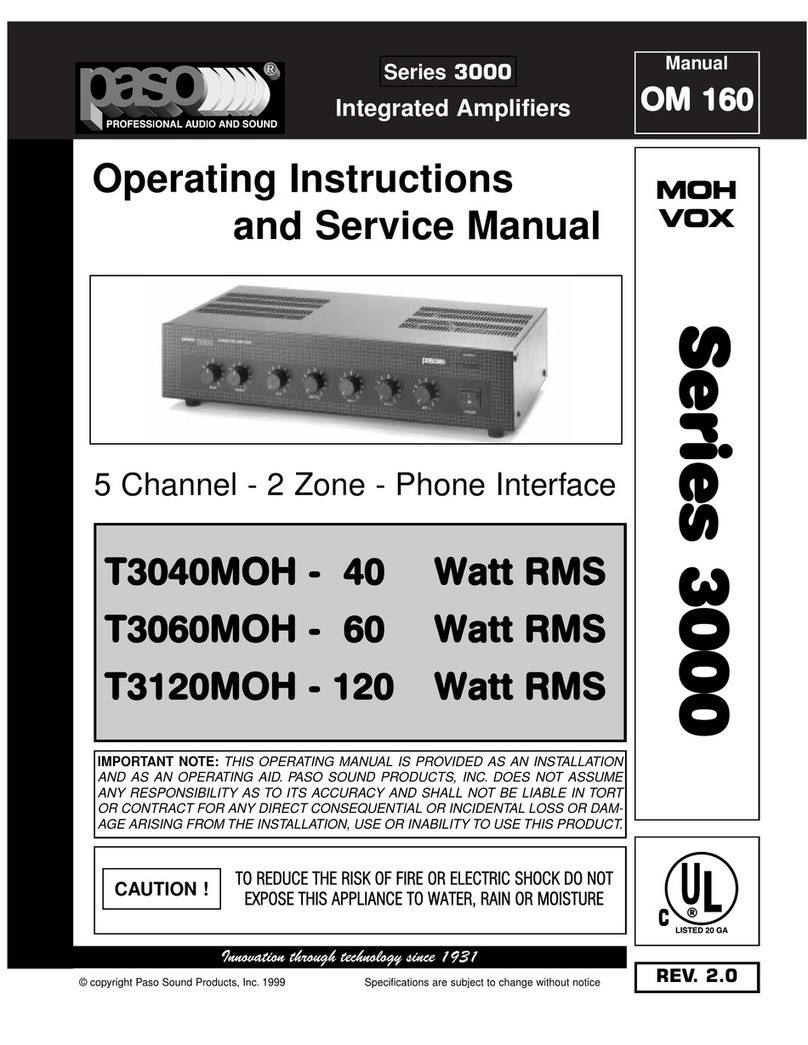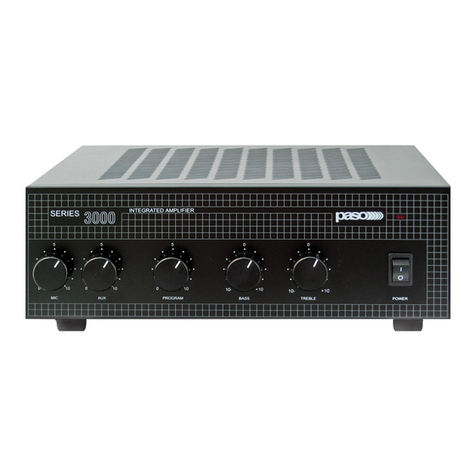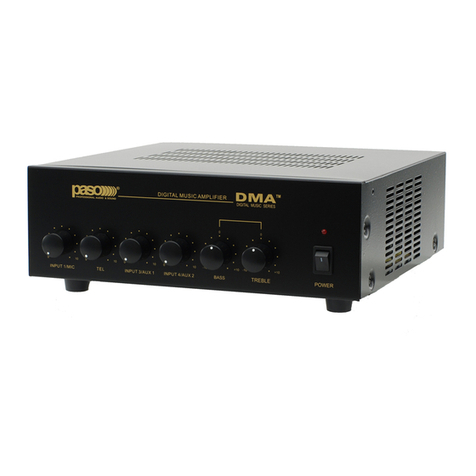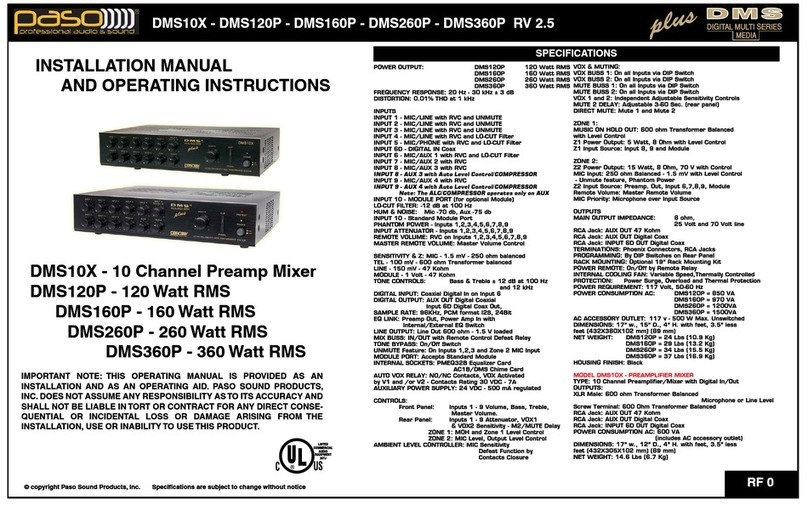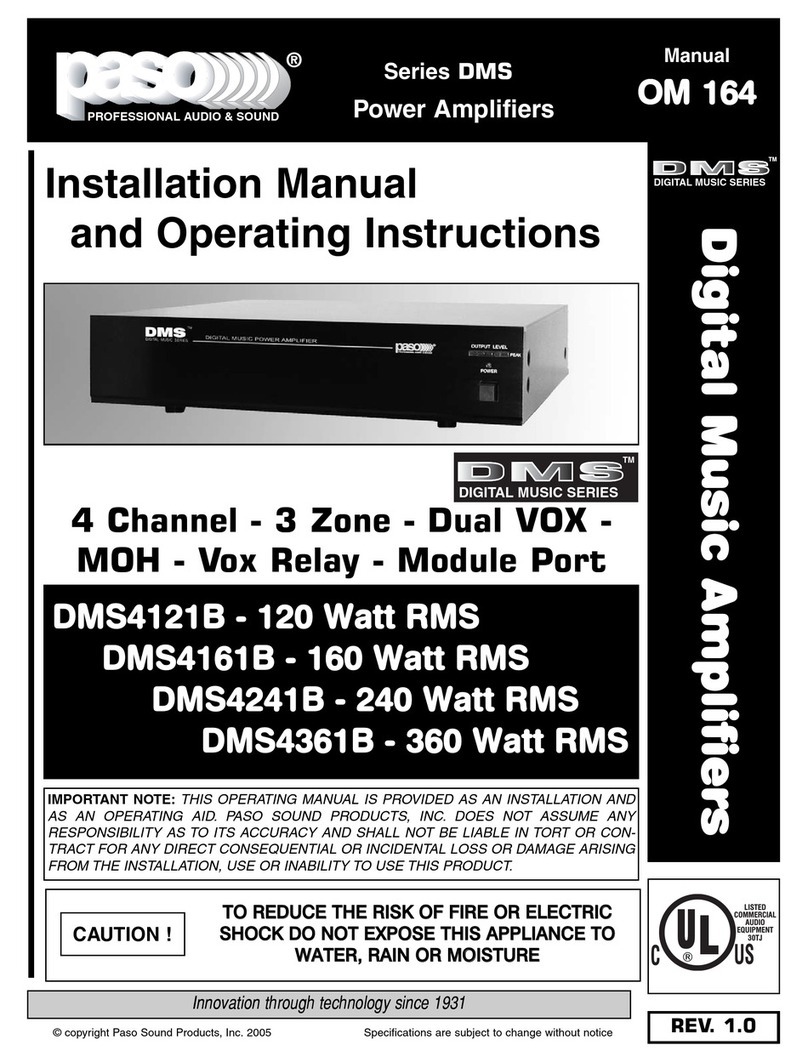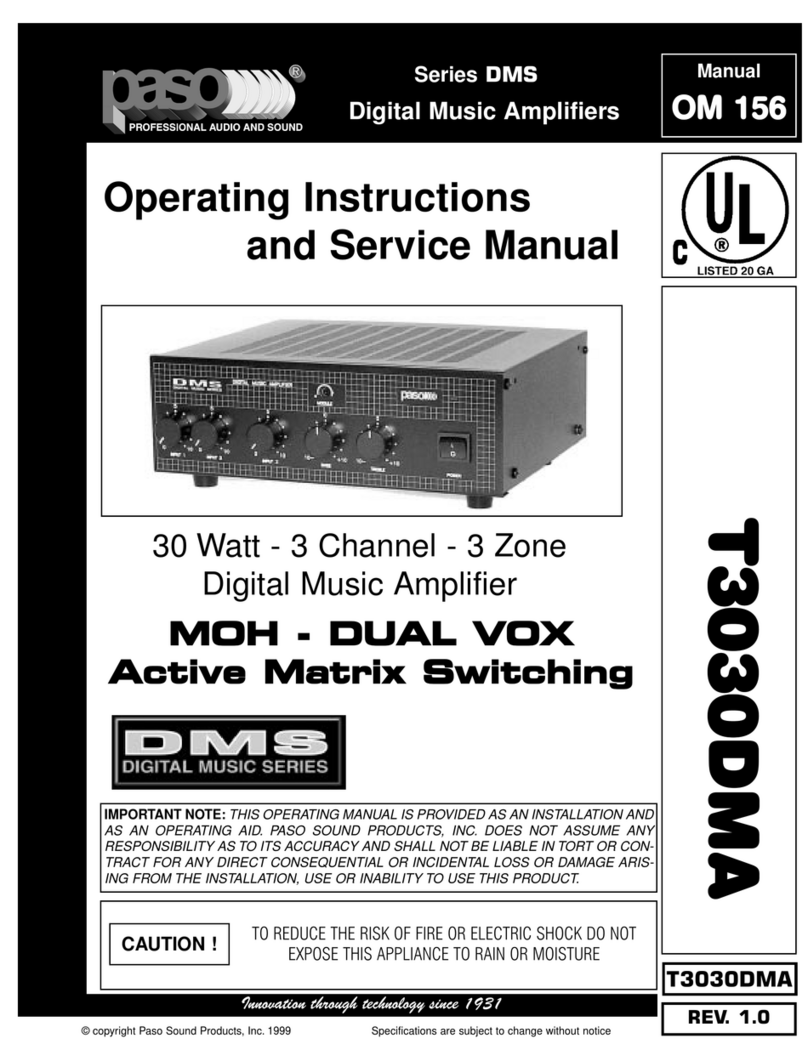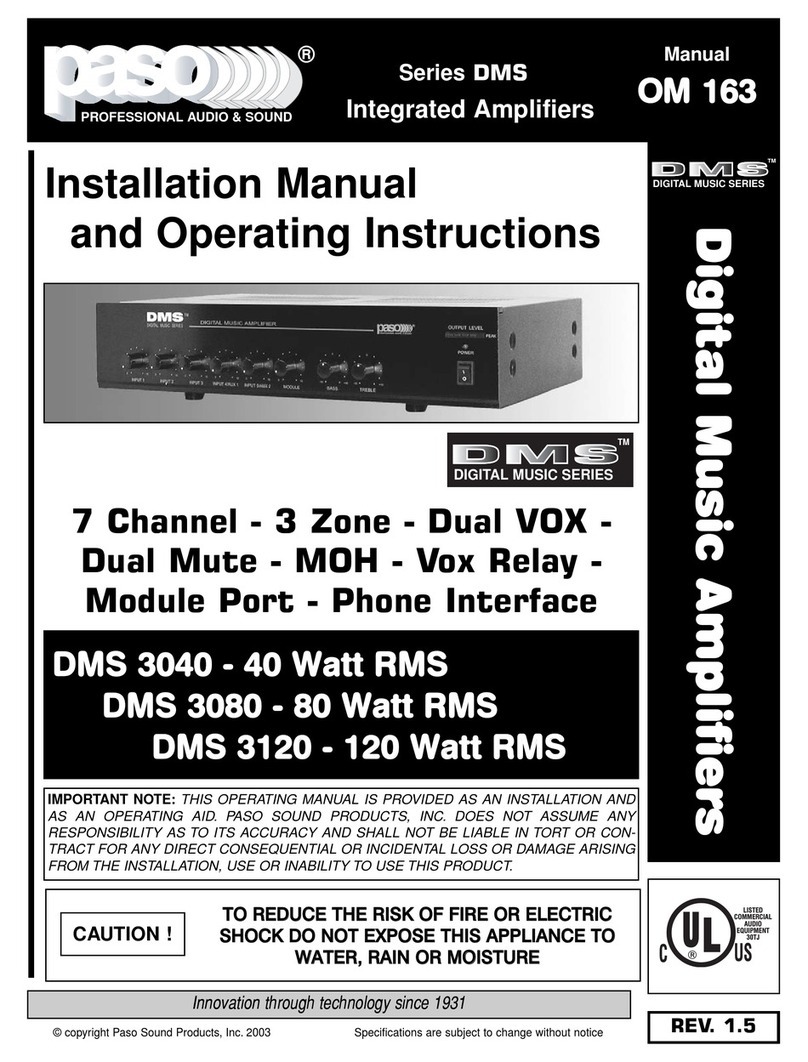DATASHEET
αα
αα
α
10
4. USO DELL’APPARECCHIO
4.1 Accensione
Prima di mettere in funzione l'apparecchio accertarsi di avere realizzato
tutte le connessioni necessarie al completamento dell'impianto e di
aver effettuato le impostazioni di funzionamento.
Portare l'interruttore di rete (6) in posizione ON.
Se necessario, regolare il livello di ascolto tramite il controllo (5) e
ritoccare i livelli delle sorgenti sonore per una corretta equalizzazione
dei segnali tramite i controlli di livello (1), (2), (3) e (4).
4.2 Controllo di volume principale
Il controllo di volume principale (5) regola il livello complessivo del segnale
d’uscita, derivato dalla miscelazione dei vari segnali di ingresso. Per
ottenere in uscita un segnale privo di distorsione, si raccomanda di
controllare che sull'indicatore del livello di uscita (7) non si accenda la
spia di colore rosso (0 dB) o, comunque, che ciò avvenga saltuariamente;
in caso contrario, è necessario diminuire il livello di uscita agendo sul
comando (5). La potenza di uscita nominale è segnalata dall'accensione
della spia luminosa rossa (0 dB).
4.3 Correzione acustica
I controlli BASS e TREBLE (4) modificano la tonalità del segnale di
uscita derivato dalla miscelazione dei vari segnali di ingresso.
• Controllo toni bassi (BASS)
Il controllo BASS regola le prestazioni dell'amplificatore alle basse
frequenze. La posizione di centro, indicata dallo “0”, fornisce una
risposta lineare; per avere una esaltazione delle frequenze basse
ruotare la manopola in senso ORARIO. Utilizzando diffusori a tromba è
opportuno tramite il comando BASS, attenuare le frequenze basse; un
eccessivo livello delle basse frequenze potrebbe danneggiare la
membrana del diffusore.
• Controllo toni acuti (TREBLE)
Il controllo TREBLE regola le prestazioni acustiche dell'amplificatore
alle alte frequenze. La posizione di centro, indicata dallo “0”, fornisce
una risposta di tipo lineare; per avere una esaltazione delle frequenze
alte ruotare la monopola in senso ORARIO. L’attenuazione dei toni
acuti è utlie per minimizzare un eccessivo livello di fruscio o per rendere
più dolci suoni particolarmente sibilanti.
4.4 Sovraccarico e protezione
Applicare un valore di impedenza di carico inferiore a quella nominale
significa richiedere all'apparecchio una potenza superiore a quella
erogabile con continuità. Questo potrebbe portare al danneggiamento
degli stadi finali di potenza e dei trasformatori di alimentazione e di
uscita. Per non incorrere in questi inconvenienti gli amplificatori della
Serie AX5500 sono abbondantemente dotati di circuiti e dispositivi di
protezione contro i sovraccarichi ed i cortocircuiti:
• circuito limitatore di picco della corrente di uscita: il suo intervento
è istantaneo ed agisce tipicamente nel caso di sovraccarico.
• interruttore termico ripristinabile: posto a contatto del dissipatore
dei transistor di potenza, interrompe l’alimentazione dei circuiti di
pilotaggio, e di conseguenza annulla il segnale di uscita, nel caso in
cui la temperatura dei finali raggiunga valori pericolosi. Il ripristino
è automatico non appena la temperatura rientra nel range di normale
funzionamento.
• fusibili di rete - accessibile sulla presa rete (27) - e di alimentazione
interna a bassa tensione (accessibile all’interno dell’apparecchio,
sul circuito d’alimentazione): questi dispositivi garantiscono il blocco
immediato del funzionamento dell’amplificatore in caso di guasto
interno dello stesso.
Da segnalare infine che tutti i modelli sono dotati di ventola di
raffreddamento, con controllo automatico della velocità in funzione
della temperatura del dissipatore su cui sono applicati i dispositivi di
potenza.
4. OPERATION
4.1 Power on
Before starting up the equipment, make sure that all the connections
required for completing the system have been made and that all the
settings for correct operation have been made. Set the mains switch
(6) to the ON position. If necessary, adjust the listening level by
means of the control (5) and adjust the levels of the sound sources for
correct equalisation of the signals by means of the level controls (1),
(2), (3) and (4).
4.2 Master volume control
The master volume control (5) adjusts the output signal overall level
as generated by mixing different input signals.
To obtain a flutter-free output signal, check that the red LED indicator
(0 dB) on the output level indicator (7) is not on, or at any rate that
it does not light up frequently; otherwise, the output level should be
reduced by the control (5). The rated output power is reached when
the red LED indicator (0 dB) lights up.
4.3 Acoustic adjustment
The BASS and TREBLE controls (4) adjust the output signal tone
generated by mixing the different input signals.
• Bass control (BASS)
The BASS control adjusts the amplifier performance at low frequencies.
The center position “0”. provides a linear response. To emphasize low
frequencies, turn the knob clockwise; to attenuate them, turn the
knob CLOCKWISE. When horn-type speakers are used, low frequencies
should be attenuated by means of the BASS control. An excessive low
frequency level could damage the speaker diaphragm.
• Treble control (TREBLE)
The TREBLE control adjusts the amplifier performance at high
frequencies. The center position “0” provides a linear response.
To emphasize high frequencies, turn the knob clockwise; to attenuate
them, turn the knob CLOCKWISE. Attenuation of the treble tones is
useful for minimising and excessive level of rustling or in order to
soften hissing sounds.
4.4 Overload and protection
Applying a load impedance value lower than the rated loan means that
the equipment is required to supply power in excess of the capacity
that can be delivered with continuity. This could lead to damage to the
final power stages and of the power supply and output transformers.
In order not to incur these upsets, the amplifiers of the AX5500
Series are equipped with a large number of circuits and devices
protecting them against overloads and short circuits:
• output current peak limiting circuit: this is tripped instantaneously
and its typical function is in the event of overloads.
• resettable thermal circuit-breaker: this is placed in contact with the
heat sink of the power transistors. It cuts off power to the driving
circuits and therefore cancels the output signal if the temperature
of the end stages reaches hazardous levels. It resets automatically
as soon as the temperature returns to within the normal operating
range.
• Mains fuses - accessible on the mains plug (27) - and on the internal
low-voltage power supply (accessible inside the equipment, on the
power supply circuit): these devices stop the amplifier working
immediately in case of internal failure inside it.
It should be pointed out, lastly, that all the models have cooling fans,
with automatic speed control depending on the temperature of the
heat sink on which the power devices are applied.
